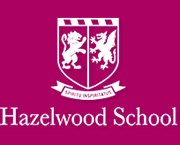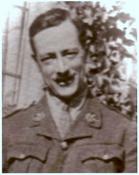
War Memorial
| 2nd Lieutenant Edward Wilfred ESTRIDGE | |
|
3rd Battalion East Yorkshire Regiment attached to B Company, 12th (Service) Battalion (3rd Hull) Date of birth: 15th May 1885 Date of death: 13th November 1916 Killed in action aged 31 Commemorated on the Thiepval Memorial Panel 2C |

|
| Edward Wilfred Estridge was born at Repton School, Repton in Derbyshire on the 15th of May 1885 the fourth son of Edward Estridge MA, an assistant school master at Repton School, and Elizabeth (nee Parry) Estridge of Repton School and of the Square House, Abington-on-Thames in Buckinghamshire. He was christened at Repton on the 15th of June 1885. He was educated at Hazelwood School until December 1898 where he was a member of the Choir. He was a member of the Cricket XI in 1898 and was a member of the 2nd Football XI in 1898. The school magazine wrote the following on his 1898 cricket season: - " With a little less lethargy might develop into a useful bat and field. " On leaving the school the magazine wrote of him: - "Goes to Repton. Nothing but constitutional delicacy, which he will soon outgrow, has prevented him being prominent in the cricket and football field; he is an excellent actor and chorister." He went on to Repton School where he was in his father's house, Brook House from 1899 to 1904 and was a member of the Officer Training Corps for four years. He passed into Trinity College Oxford in the spring of 1904 where he read classics and served as a member of the Oxford University Officer Training Corps. He rowed in the First Torpid in 1905. Having failed his examinations twice during 1905 he had planned to transfer to study history but instead he left Oxford at December 1905 to go into business. He left for Canada in 1911 where he farmed with his younger brother at Victoria in British Columbia. While he lived there he served as Private 1025 in the 50th Militia (Gordon Highlanders). Following the outbreak of war he enlisted as Private 77857 in the 88th Canadian Fusiliers (British Columbia) Regiment at Victoria in British Columbia on the 30th of November 1914. At a medical examination, which had been held on the 25th of November, it was recorded that he was six feet one and a half inches tall with a fresh complexion, brown eyes and brown hair. He embarked for overseas service at Halifax on board the SS "Megantic" on the 23rd of February 1915 with the 30th Battalion Canadian Infantry. On his arrival he was based at Napier Barracks at Shorncliffe in Kent. On the 24th of April 1915 he was admitted to Shorncliffe Hospital suffering from tonsillitis and was discharged to duty on the 3rd of May. He applied for a commission in the Special Reserve of Officers on the 25th of May 1915, expressing a preference for a commission in the 3rd Battalion East Yorkshire Regiment, and was posted to Bedford for officer training on the 18th of June 1915. He was commissioned as a 2nd Lieutenant in the 3rd (Reserve) Battalion of the East Yorkshire Regiment (Special Reserve) on the 14th of June 1915 and was posted to the 12th (Service) Battalion. He served as Brigade Bombing Officer from March to August 1916. On the 10th of November 1916 the 12th Battalion East Yorkshire Regiment marched from Warnimont Wood to Rossignol Farm in preparation for an attack to the north of Serre on the Somme as part of the Battle of the Ancre. On the 12th of November they moved into the front line trenches at 10pm. The attack began at 5.45am the following morning when the supporting artillery barrage intensified and the battalion advanced in four tightly packed waves into a fog which maintained the darkness. They crossed the German first line trench almost without realising and with few casualties, such was the annihilation caused by the British guns. Edward Estridge was shot and killed as he led his men into the German trench. All Germans found there were killed or taken prisoner; they captured three hundred German prisoners who were sent back to the British lines, although less than half survived the crossing. The German support line was taken eventually after heavy fighting, recorded as being of the most savage of its kind, much of it hand-to hand with “the use of bombs and the bayonet being widespread “. One group under Captain Wooley advanced as far as the third line but, after heavy fighting, were forced to surrender when the Germans advanced towards them, shepherding captured British prisoners in front of them. By now the East Yorkshires were on their own due to the failure of the attack of 3rd Division to their right and it was decided that the position would soon become untenable. At 5.30pm orders were given to withdraw, the evacuation being completed by 9.30pm. During this action Private John Cunningham of the battalion won the Victoria Cross. The battalion’s casualties were some 383 of whom 139 had died, with German losses being estimated at over 1,000. His father received the following telegram dated the 17th of November 1916: - "Deeply regret to inform you 2nd Lieut. E.W. Estridge 3rd attd 12 East Yorkshire Regt. was killed in action Nov 13th. The Army Council express their sympathy." His Colonel wrote of him: - “He had only been with this Battalion a few months, but during that time had made himself most popular with all ranks and proved himself to be a most efficient officer. He was killed leading his Platoon into the German first line. Directly he jumped into the trench he was shot by a German, who immediately bolted down a dug-out. All the men in the dug-out were eventually captured or killed. I cannot express in words how I felt his loss; he was always ready to do anything, and he was always cheerful; his place will indeed be hard to fill.” He is commemorated on the war memorial at Repton School, on the memorial at Trinity College Oxford and on the memorial at Duncan, British Columbia. |
|
 | |
| Went on to Repton School |
Back